Assessment of the Effect of Climate Change on Wheat Storage in Northwestern Tunisia: Control of Rhyzopertha dominica by Aeration
Abstract
:1. Introduction
2. Materials and Methods
2.1. Study Sites
2.2. Climate Change Projections
2.3. Conceptual Flow Chart
2.4. Storage Bin Model
2.5. Insect Dynamic Model
3. Results
3.1. Ambient Air Aeration Feasibility Analysis
3.2. Impact of Climate Change on R. dominica Dynamics
4. Discussion
5. Conclusions
Author Contributions
Funding
Institutional Review Board Statement
Data Availability Statement
Acknowledgments
Conflicts of Interest
References
- West, P.C.; Gerber, J.S.; Engstrom, P.M.; Mueller, N.D.; Brauman, K.A.; Carlson, K.M.; Cassidy, E.S.; Johnston, M.; MacDonald, G.K.; Ray, D.K.; et al. Leverage points for improving global food security and the environment. Science 2014, 345, 325–328. [Google Scholar] [CrossRef] [Green Version]
- Schlenker, W.; Lobell, D.B. Robust negative impacts of climate change on African agriculture. Environ. Res. Lett. 2010, 5, 014010. [Google Scholar] [CrossRef]
- Grami, D.; Ben Rejeb, J. The impact of climate change on the yield of cereal crops in the Northwest area of Tunisia (Beja). New Medit 2015, 14, 36–41. [Google Scholar]
- Adhikari, U.; Nejadhashemi, A.P.; Woznicki, S.A. Climate change and eastern Africa: A review of impact on major crops. Food Energy Secur. 2015, 4, 110–132. [Google Scholar] [CrossRef]
- Roudier, P.; Sultan, B.; Quirion, P.; Berg, A. The impact of future climate change on West African crop yields: What does the recent literature say? Glob. Environ. Chang. 2011, 21, 1073–1083. [Google Scholar] [CrossRef] [Green Version]
- Mougou, R.; Mansour, M.; Iglesias, A.; Chebbi, R.Z.; Battaglini, A. Climate change and agricultural vulnerability: A case study of rain-fed wheat in Kairouan, Central Tunisia. Reg. Environ. Chang. 2011, 11, 137–142. [Google Scholar] [CrossRef] [Green Version]
- Lhomme, J.P.; Mougou, R.; Mansour, M. Potential impact of climate change on durum wheat cropping in Tunisia. Clim. Chang. 2009, 96, 549–564. [Google Scholar] [CrossRef]
- Nouna, B.; Jebari, S.; Rezig, M.; Khlifi, A.; Amor, A. Assessment of climate change impact on durum wheat in semi-arid conditions of Tunisia. Annales De L’INRGREF 2014, 19, 156–170. [Google Scholar]
- Prakash, A.; Rao, J. Insect pest management in stored-rice ecosystems. In Stored-Grain Ecosystems; Marcel Dekker: New York, NY, USA, 1995; pp. 709–736. [Google Scholar]
- Bashir, T. Reproduction of Rhyzopertha dominica (F.) (Coleoptera: Bostrichidae) on different host-grains. Pak. J. Biol. Sci. 2002, 5, 91–93. [Google Scholar] [CrossRef]
- Hill, D.S. Pests of Stored Foodstuffs and Their Control; Springer Science & Business Media: Berlin/Heidelberg, Germany, 2002. [Google Scholar]
- Navarro, S.; Noyes, R.; Jayas, D.S. Stored grain ecosystem and heat, and moisture transfer in grain bulks. In The Mechanics and Physics of Modern Grain Aeration Management; CRC Press Inc.: Boca Raton, FL, USA, 2002; pp. 35–78. [Google Scholar]
- Rees, D.P. Insects of Stored Products; CSIRO Publishing: Clayton, Australia, 2004. [Google Scholar]
- Birch, L. The influence of temperature on the development of the different stages of Calandra oryzae L. and Rhizopertha dominica Fab. (Coleoptera). Aust. J. Exp. Biol. Med Sci. 1945, 23, 29–35. [Google Scholar] [CrossRef]
- Fleurat-Lessard, F. Qualitative reasoning and integrated management of the quality of stored grain: A promising new approach. J. Stored Prod. Res. 2002, 38, 191–218. [Google Scholar] [CrossRef]
- Bareil, N.; Crépon, K.; Piraux, F. Prediction of insect mortality in cooled stored grain. J. Stored Prod. Res. 2018, 78, 110–117. [Google Scholar] [CrossRef]
- Abadia, M.B.; Urcola, H.A.; Ferrari, M.C.; Bartosik, R.E. Is the argentine postharvest system ready to handle more and better grains? J. Stored Prod. Res. 2019, 83, 218–226. [Google Scholar] [CrossRef]
- Lopes, D.C.; Neto, A.J.S. Effects of climate change on the aeration of stored beans in Minas Gerais State, Brazil. Biosyst. Eng. 2019, 188, 155–164. [Google Scholar] [CrossRef]
- Li, X.; Han, Z.; Lin, Q.; Wu, Z.; Chen, L.; Zhang, Q. Smart cooling-aeration guided by aeration window model for paddy stored in concrete silos in a depot of Guangzhou, China. Comput. Electron. Agric. 2020, 173, 105452. [Google Scholar] [CrossRef]
- Neto, A.J.S.; de Carvalho Lopes, D. Thermistor based system for grain aeration monitoring and control. Comput. Electron. Agric. 2015, 116, 45–54. [Google Scholar] [CrossRef]
- Arthur, F.; Casada, M. Directional flow of summer aeration to manage insect pests in stored wheat. Appl. Eng. Agric. 2010, 26, 115–122. [Google Scholar] [CrossRef]
- Daglish, G.J.; Nayak, M.K.; Arthur, F.H.; Athanassiou, C.G. Insect pest management in stored grain. Recent Advances in Stored Product Protection; Springer: Berlin/Heidelberg, Germany, 2018; pp. 45–63. [Google Scholar]
- Reed, C.; Harner III, J. Cooling of stored wheat in multiple or single cycles using automatic aeration controllers. Appl. Eng. Agric. 1998, 14, 497–500. [Google Scholar] [CrossRef]
- Reed, C.; Harner III, J. Thermostatically controlled aeration for insect control in stored hard red winter wheat. Appl. Eng. Agric. 1998, 14, 501–505. [Google Scholar] [CrossRef]
- de Carvalho Lopes, D.; Martins, J.H.; Lacerda Filho, A.F.; de Castro Melo, E.; de Barros Monteiro, P.M.; de Queiroz, D.M. Aeration strategy for controlling grain storage based on simulation and on real data acquisition. Comput. Electron. Agric. 2008, 63, 140–146. [Google Scholar] [CrossRef] [Green Version]
- Moses, J.; Jayas, D.; Alagusundaram, K. Climate change and its implications on stored food grains. Agric. Res. 2015, 4, 21–30. [Google Scholar] [CrossRef]
- Gregori, R.; Meriggi, P.; Pietri, A.; Formenti, S.; Baccarini, G.; Battilani, P. Dynamics of fungi and related mycotoxins during cereal storage in silo bags. Food Control 2013, 30, 280–287. [Google Scholar] [CrossRef]
- Arthur, F.; Siebenmorgen, T. Historical weather data and predicted aeration cooling periods for stored rice in Arkansas. Appl. Eng. Agric. 2005, 21, 1017–1020. [Google Scholar] [CrossRef]
- Arthur, F.; Casada, M. Feasibility of summer aeration to control insects in stored wheat. Appl. Eng. Agric. 2005, 21, 1027–1038. [Google Scholar] [CrossRef]
- Morrison III, W.R.; Arthur, F.H.; Wilson, L.T.; Yang, Y.; Wang, J.; Athanassiou, C.G. Aeration to manage insects in wheat stored in the Balkan peninsula: Computer simulations using historical weather data. Agronomy 2020, 10, 1927. [Google Scholar] [CrossRef]
- Radhouane, L. Climate change impacts on North African countries and on some Tunisian economic sectors. J. Agric. Environ. Int. Dev. (JAEID) 2013, 107, 101–113. [Google Scholar]
- al Hajj, Z. Mediterranean Blues: Facing Environmental Crises. Middle East Rep. 2000, 216, 26–27. [Google Scholar] [CrossRef]
- Erenstein, O.; Chamberlin, J.; Sonder, K. Estimating the global number and distribution of maize and wheat farms. Glob. Food Secur. 2021, 30, 100558. [Google Scholar] [CrossRef]
- Kruseman, G.; Mottaleb, K.A.; Tesfaye, K.; Bairagi, S.; Robertson, R.; Mandiaye, D.; Frija, A.; Gbegbelegbe, S.; Alene, A.; Prager, S. Rural transformation and the future of cereal-based agri-food systems. Glob. Food Secur. 2020, 26, 100441. [Google Scholar] [CrossRef]
- Wright, B.; Cafiero, C. Grain reserves and food security in the Middle East and North Africa. Food Secur. 2011, 3, 61–76. [Google Scholar] [CrossRef] [Green Version]
- Khaldi, R.; Saaidia, B. Analyse de la Filière Céréalière en Tunisie et Identification des Principaux Points de Dysfonctionnement à L’origine des Pertes. Rapport de Projet FAO (GCP/RNE/004/ITA). Available online: http://www.onagri.nat.tn/uploads/Etudes/RapportIVF.pdf (accessed on 1 February 2022).
- Attiaoui, I.; Boufateh, T. Impacts of climate change on cereal farming in Tunisia: A panel ARDL–PMG approach. Environ. Sci. Pollut. Res. 2019, 26, 13334–13345. [Google Scholar] [CrossRef]
- African Development Bank 2023. Tunisie: Pacte Pour l’Alimentation et l’Agriculture. Available online: https://www.afdb.org/en/documents/tunisie-pacte-pour-lalimentation-et-lagriculture (accessed on 1 February 2022).
- Salehie, O.; Ismail, T.b.; Hamed, M.M.; Shahid, S.; Idlan Muhammad, M.K. Projection of hot and cold extremes in the Amu River basin of Central Asia using GCMs CMIP6. Stoch. Environ. Res. Risk Assess. 2022, 36, 3395–3416. [Google Scholar] [CrossRef]
- Pollmer, U. Cultural Heritage in Crisis: Cultural Heritage Research at European Level–Challenges in Times of Climate Change and Digitalization; Fraunhofer Center for International Management and Knowledge Economy IMW: Leipzig, Germany, 2020. [Google Scholar]
- Eyring, V.; Bony, S.; Meehl, G.; Senior, C.; Stevens, B.; Stouffer, R.; Taylor, K. Overview of the Coupled Model Intercomparison Project Phase 6 (CMIP6) experimental design and organisation. Geosci. Model Dev. Discuss. 2015, 8, 112. [Google Scholar]
- Séférian, R.; Bopp, L.; Gehlen, M.; Orr, J.C.; Ethé, C.; Cadule, P.; Aumont, O.; Salas y Mélia, D.; Voldoire, A.; Madec, G. Skill assessment of three earth system models with common marine biogeochemistry. Clim. Dyn. 2013, 40, 2549–2573. [Google Scholar] [CrossRef] [Green Version]
- Teutschbein, C.; Seibert, J. Bias correction of regional climate model simulations for hydrological climate-change impact studies: Review and evaluation of different methods. J. Hydrol. 2012, 456, 12–29. [Google Scholar] [CrossRef]
- Lindström, G.; Johansson, B.; Persson, M.; Gardelin, M.; Bergström, S. Development and test of the distributed HBV-96 hydrological model. J. Hydrol. 1997, 201, 272–288. [Google Scholar] [CrossRef]
- Arthur, F.H.; Throne, J.E.; Maier, D.E.; Montross, M.D. Feasibility of aeration for management of maize weevil populations in corn stored in the southern United States: Model simulations based on recorded weather data. Am. Entomol. 1998, 44, 118–123. [Google Scholar] [CrossRef]
- Howe, R. A summary of estimates of optimal and minimal conditions for population increase of some stored products insects. J. Stored Prod. Res. 1965, 1, 177–184. [Google Scholar] [CrossRef]
- Fields, P.G. The control of stored-product insects and mites with extreme temperatures. J. Stored Prod. Res. 1992, 28, 89–118. [Google Scholar] [CrossRef]
- Noyes, R.; Clary, B.; Cuperus, G. Maintaining the Quality of Stored Wheat by Aeration; Oklahoma State University Cooperative Extension Service Fact Sheet; Oklahoma State University: Stillwater, OK, USA, 1992; Volume 1100. [Google Scholar]
- Iguaz, A.; Arroqui, C.; Esnoz, A.; Vírseda, P. Modelling and validation of heat transfer in stored rough rice without aeration. Biosyst. Eng. 2004, 88, 429–439. [Google Scholar] [CrossRef]
- Jia, C.C.; Sun, D.W.; Cao, C.W. Mathematical simulation of temperature fields in a stored grain bin due to internal heat generation. J. Food Eng. 2000, 43, 227–233. [Google Scholar] [CrossRef]
- Birch, L. The effect of temperature and dryness on the survival of the eggs of Calandra oryzae L. (small strain) and Rhizopertha dominica Fab. (Coleoptera). Aust. J. Exp. Biol. Med. Sci. 1944, 22, 265–269. [Google Scholar] [CrossRef]
- Birch, L. The mortality of the immature stages of Calandra oryzae L. (small strain) and Rhizopertha dominica Fab. in wheat of different moisture contents. Aust. J. Exp. Biol. Med. Sci. 1945, 23, 141–145. [Google Scholar] [CrossRef]
- Longstaff, B.C. An experimental and modelling study of the demographic performance of Rhyzopertha dominica (F.). I. Development rate. J. Stored Prod. Res. 1999, 35, 89–98. [Google Scholar] [CrossRef]
- Birch, L.C. Experimental Background to the Study of the Distribution and Abundance of Insects: II. The Relation Between Innate Capacity for Increase in Numbers and the Abundance of Three Grain Beetles in Experimental Populations. Ecology 1953, 34, 712–726. [Google Scholar] [CrossRef]
- Quarles, W. Global warming means more pests. IPM Pract. 2007, 29, 1–8. [Google Scholar]
- Yang, Y.; Wilson, L.T.; Arthur, F.H.; Wang, J.; Jia, C. Regional analysis of bin aeration as an alternative to insecticidal control for post-harvest management of Sitophilus oryzae (L.) and Rhyzopertha dominica (F.). Ecol. Model. 2017, 359, 165–181. [Google Scholar] [CrossRef]
- Flinn, P.; Hagstrum, D.; Muir, W.; Sudayappa, K. Spatial model for simulating changes in temperature and insect population dynamics in stored grain. Environ. Entomol. 1992, 21, 1351–1356. [Google Scholar] [CrossRef]
- Flinn, P.W.; Hagstrum, D.W.; Reed, C.; Phillips, T.W. Simulation model of Rhyzopertha dominica population dynamics in concrete grain bins. J. Stored Prod. Res. 2004, 40, 39–45. [Google Scholar] [CrossRef]
- Driscoll, R.; Longstaff, B.; Beckett, S. Prediction of insect populations in grain storage. J. Stored Prod. Res. 2000, 36, 131–151. [Google Scholar] [CrossRef]
- Burks, C.S.; Johnson, J.A.; Maier, D.E.; Heaps, J.W. Temperature. In Alternatives to Pesticides in Stored-Product IPM; Subramanyam, B., Hagstrum, D.W., Eds.; Springer: Boston, MA, USA, 2000; pp. 73–104. [Google Scholar]
- Mason, L.J.; Strait, C.A. Stored product integrated pest management with extreme temperatures. In Temperature Sensitivity in Insects and Application in Integrated Pest Management; CRC Press: Boca Raton, FL, USA, 2019; pp. 141–177. [Google Scholar]
- Mohapatra, S.; Raghu, S.; Prasanthi, G.; Baite, M.; Prabhukarthikeyan, S.; Yadav, M.; Banerjee, A.; Aravindan, S.; Patil, N.; Chatterjee, S.; et al. Bio-Ecology of Rice Insect Pests and Diseases: Paving the Way to Climate-Smart Rice Protection Technologies; ICAR-National Rice Research Institute: Cuttack Odisha, India, 2018. [Google Scholar]
- Scheff, D.S.; Campbell, J.F.; Arthur, F.H. Seasonal, landscape, and attractant effects on lesser grain borer, Rhyzopertha dominica (F.), captures in Northeast Kansas. Agronomy 2021, 12, 99. [Google Scholar] [CrossRef]
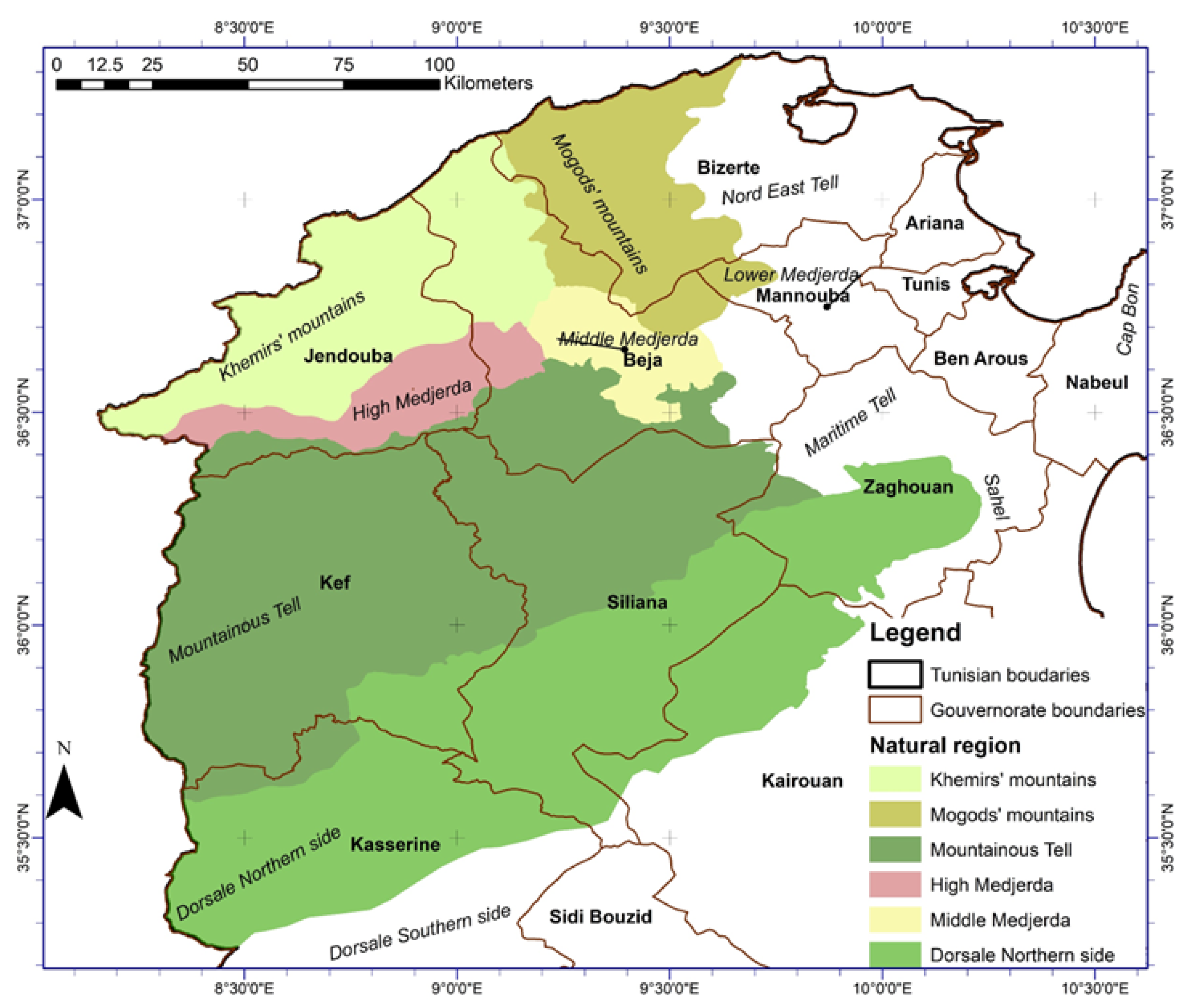
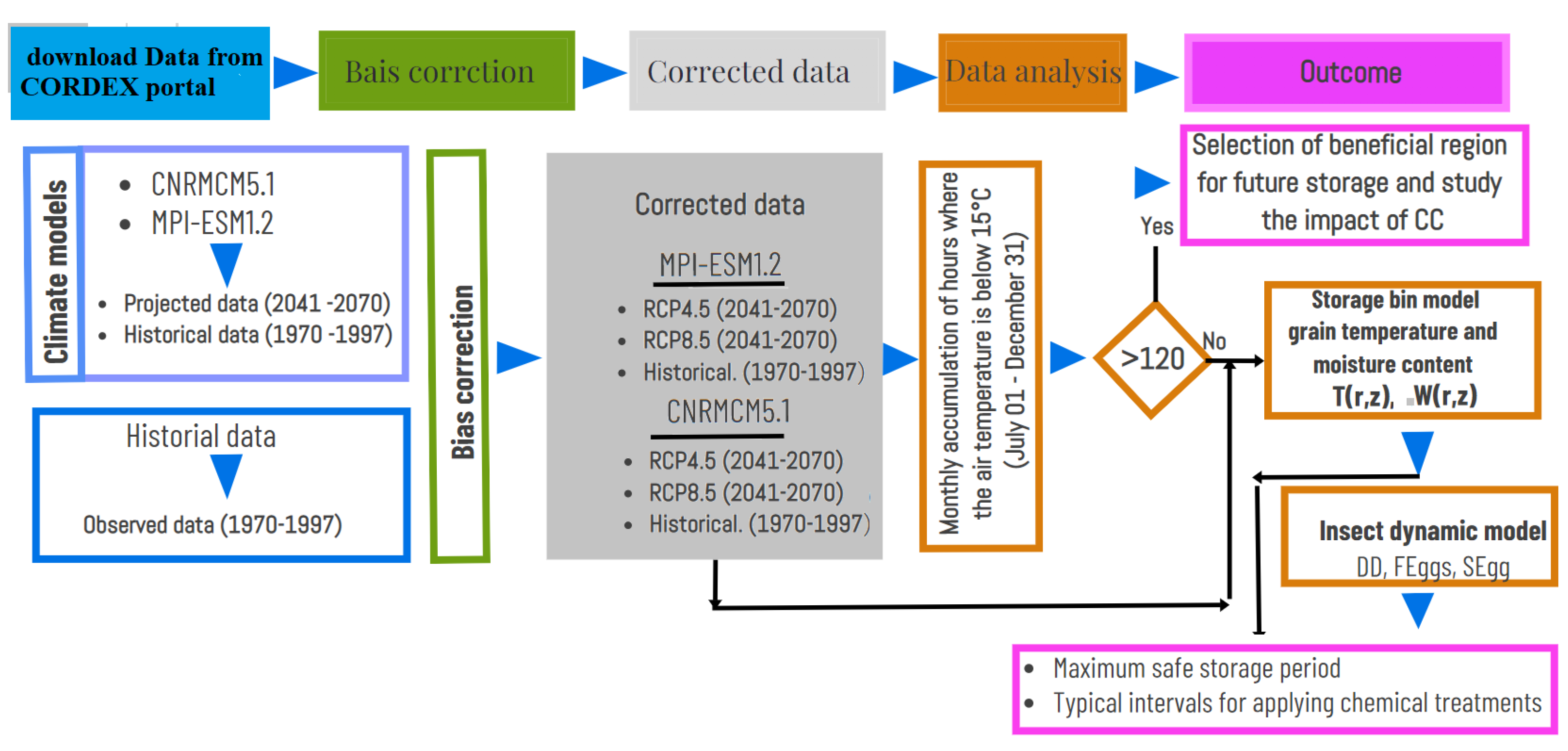
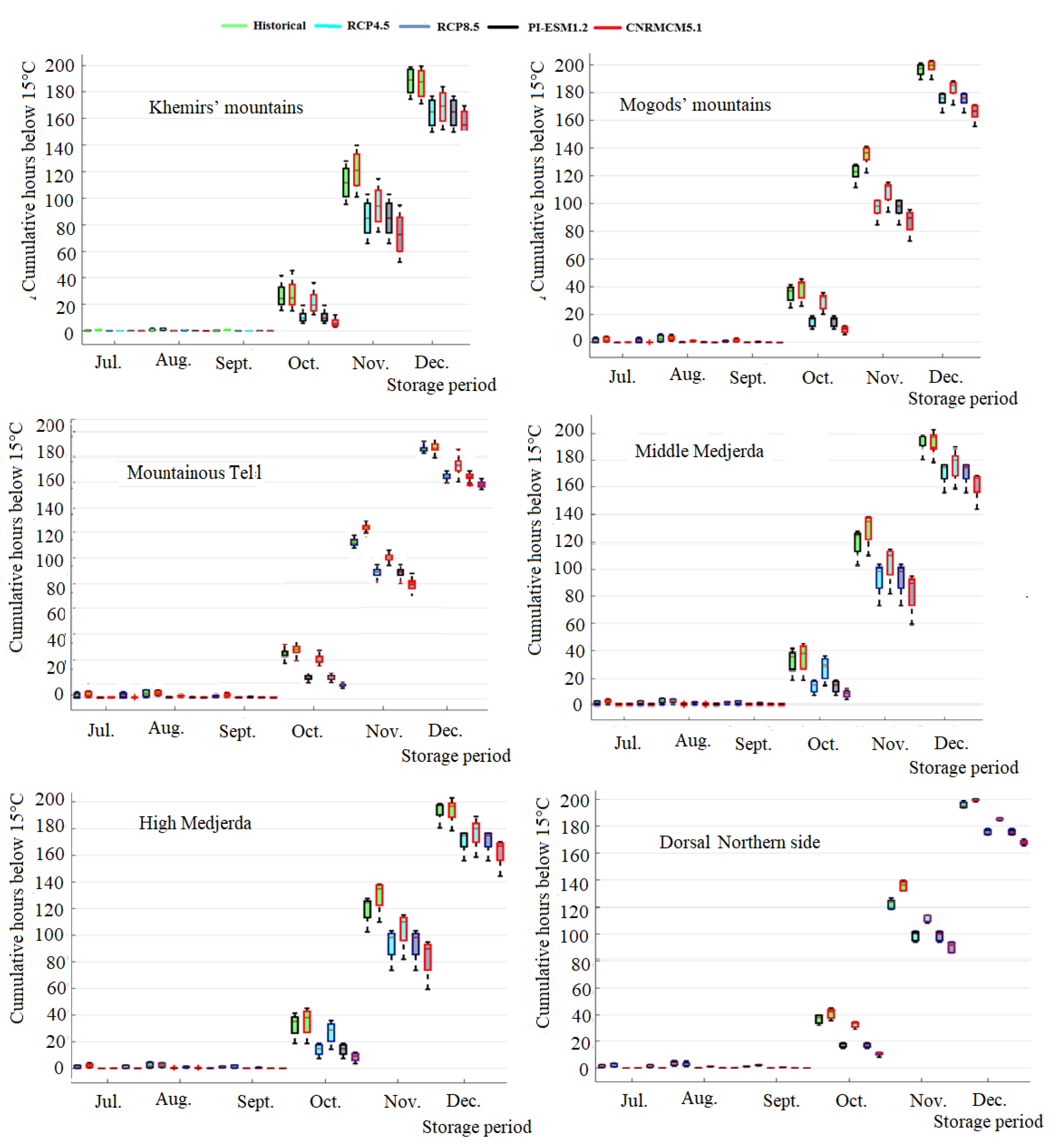
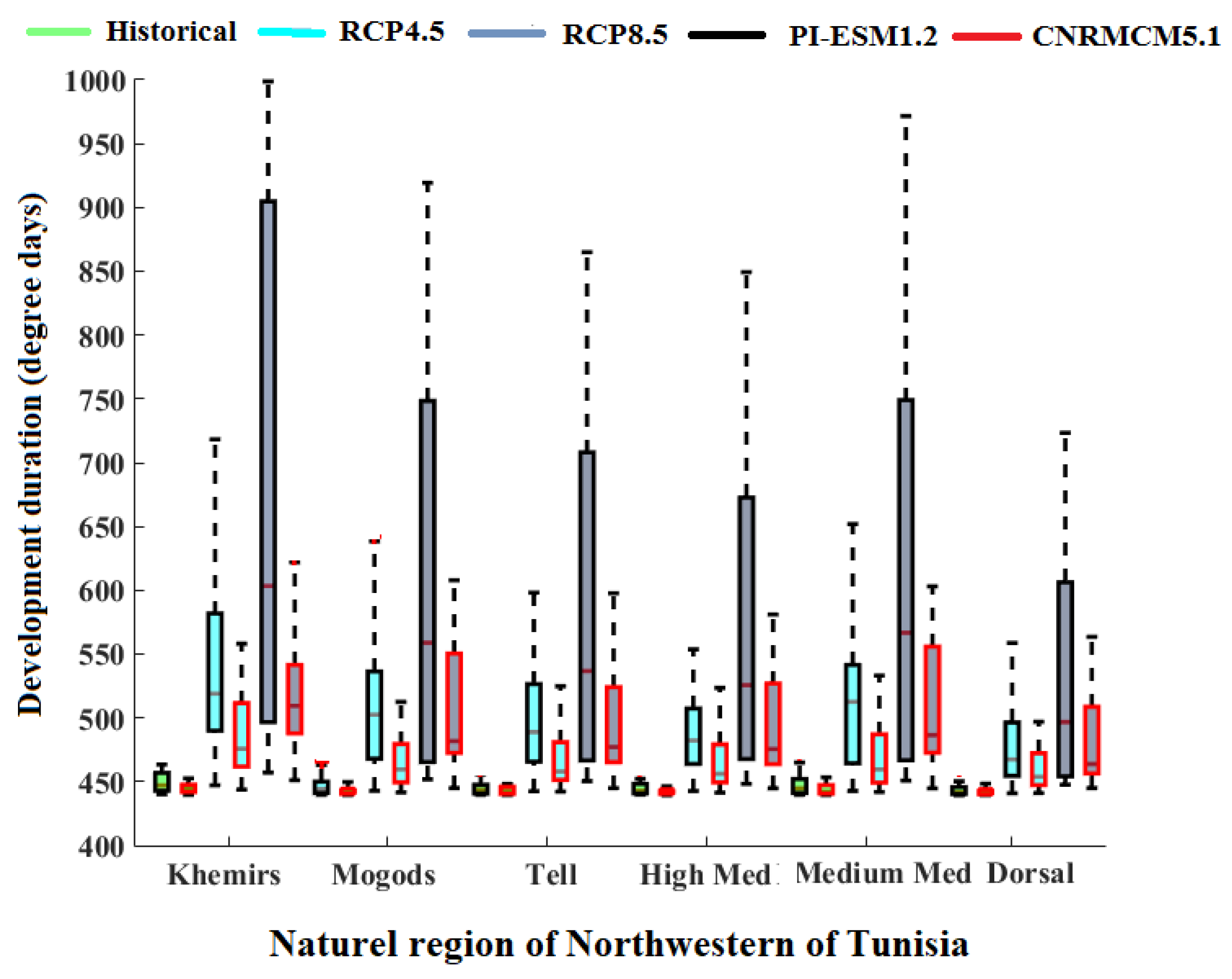
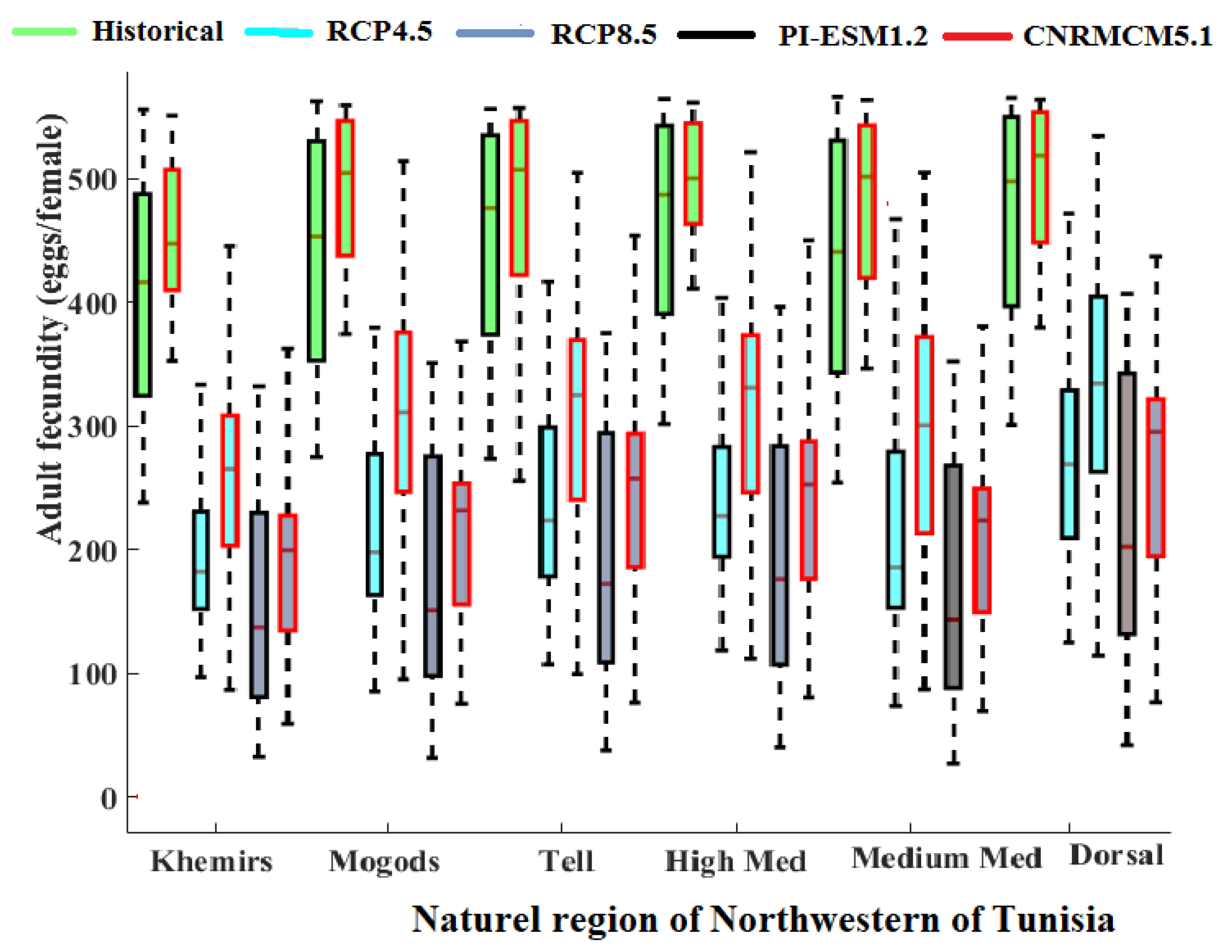
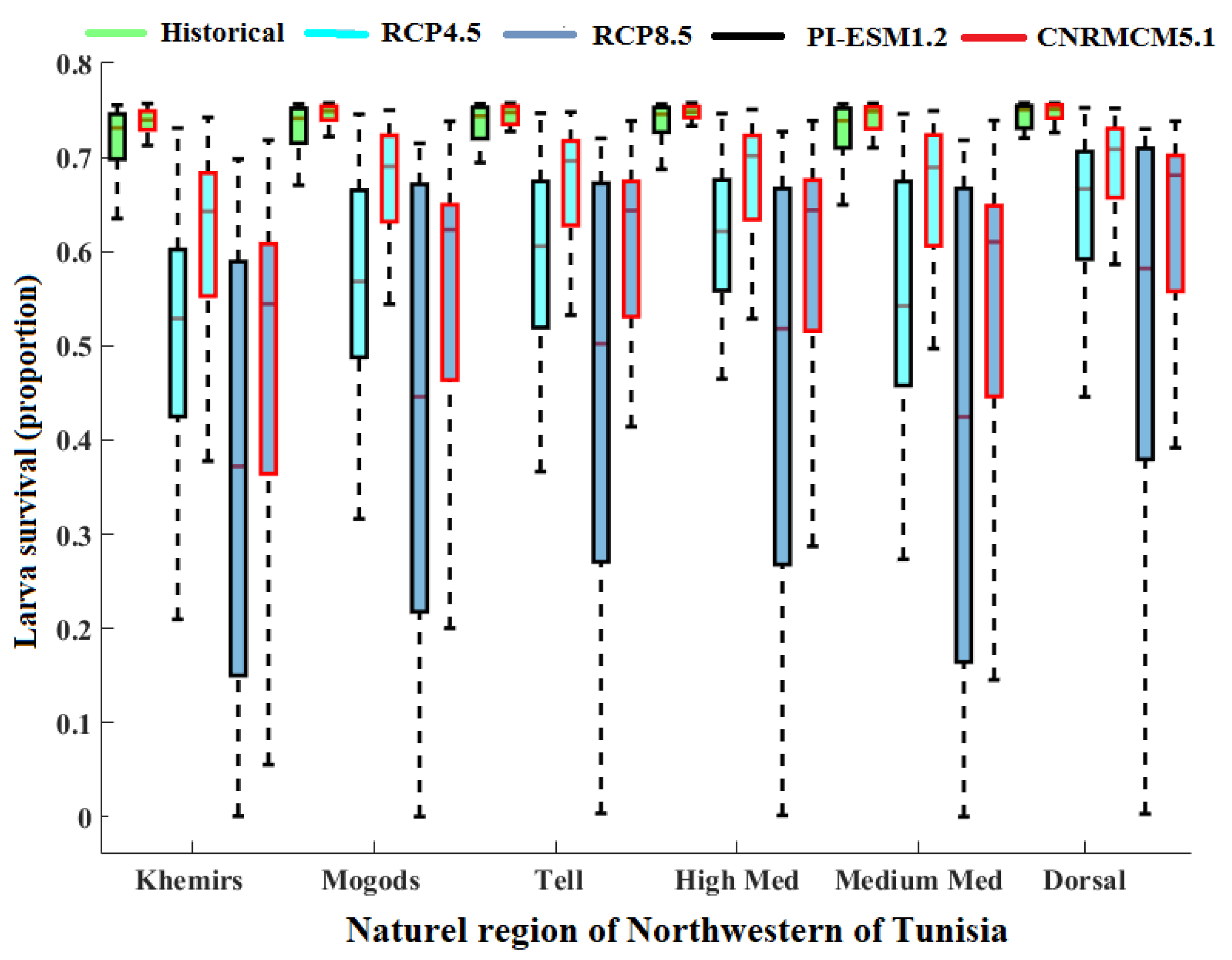
| Natural Region | Area (km²) | Latitude | Longitude | Number of Cells for Climate Projection |
|---|---|---|---|---|
| Khemir mountains | 2984.4 | 36.54 to 37.05 | 8.11 to 9.07 | 21 |
| Mogods mountain range | 2210.3 | 36.76 to 37.21 | 9.14 to 9.57 | 13 |
| Mountainous Tell | 8384.6 | 35.92 to 36.65 | 8.71 to 10.73 | 60 |
| High Medjerda | 999.5 | 36.6 to 36.43 | 8.43 to 8.96 | 7 |
| Middle Medjerda | 456.7 | 36.64 to 36.75 | 9.47 to 9.90 | 5 |
| Dorsale—northwestern side | 7606.8 | 37.27 to 35.07 | 10.79 to 8.02 | 52 |
| Dynamic Parameter | Equation | Parameter | Source | |
|---|---|---|---|---|
| DD | ||||
| (3) | 0.97 | Birch [54] | ||
| FEggs | ||||
| (4) | 0.99 | Birch [54] | ||
| (5) | 0.98 | Birch [54] | ||
| Natural Region | October | November | December |
|---|---|---|---|
| Khemir mountains | 9.00 | 18.15 | 31.36 |
| Mogods mountain range | 12.17 | 17.91 | 37.76 |
| Mountainous Tell | 11.24 | 17.29 | 37.64 |
| High Medjerda | 12.68 | 17.25 | 36.85 |
| Middle Medjerda | 11.11 | 17.70 | 37.69 |
| Dorsale—northern side | 12.12 | 17.69 | 37.9 |
| Model | Comparison | DD | FEggs | SEggL |
|---|---|---|---|---|
| MPI-ESM1.2 | (Historical-RCP8.5) | 149.53 *** | 194.71 ** | 0.16 * |
| (Historical-RCP4.5) | 55.42 *** | 252.06 ** | 0.30 * | |
| CNRM-CM5.1 | (Historical-RCP8.5) | 96.58 *** | 124.29 *** | 0.18 *** |
| (Historical-RCP4.5) | 33.57 *** | 162.54 *** | 0.14 *** |
Disclaimer/Publisher’s Note: The statements, opinions and data contained in all publications are solely those of the individual author(s) and contributor(s) and not of MDPI and/or the editor(s). MDPI and/or the editor(s) disclaim responsibility for any injury to people or property resulting from any ideas, methods, instructions or products referred to in the content. |
© 2023 by the authors. Licensee MDPI, Basel, Switzerland. This article is an open access article distributed under the terms and conditions of the Creative Commons Attribution (CC BY) license (https://creativecommons.org/licenses/by/4.0/).
Share and Cite
El Melki, M.N.; Al-Khayri, J.M.; Aldaej, M.I.; Almaghasla, M.I.; El Moueddeb, K.; Khlifi, S. Assessment of the Effect of Climate Change on Wheat Storage in Northwestern Tunisia: Control of Rhyzopertha dominica by Aeration. Agronomy 2023, 13, 1773. https://doi.org/10.3390/agronomy13071773
El Melki MN, Al-Khayri JM, Aldaej MI, Almaghasla MI, El Moueddeb K, Khlifi S. Assessment of the Effect of Climate Change on Wheat Storage in Northwestern Tunisia: Control of Rhyzopertha dominica by Aeration. Agronomy. 2023; 13(7):1773. https://doi.org/10.3390/agronomy13071773
Chicago/Turabian StyleEl Melki, Mohamed Nejib, Jameel Mohammed Al-Khayri, Mohammed Ibrahim Aldaej, Mustafa Ibrahim Almaghasla, Khaled El Moueddeb, and Slaheddine Khlifi. 2023. "Assessment of the Effect of Climate Change on Wheat Storage in Northwestern Tunisia: Control of Rhyzopertha dominica by Aeration" Agronomy 13, no. 7: 1773. https://doi.org/10.3390/agronomy13071773








